The Context
Certain recent developments suggest that “Ireland may have reached a tipping point where climate action is now broadly and deeply accepted.” Those developments include the Citizens’ Assembly’s strong recommendations on climate action, the Climate Change Advisory Council’s increasing proactive role in pushing the government, and some recent research sponsored by EPA. (See Tipping Point below) At the same time, there are countervailing forces at work that keep Ireland’s government lagging others on climate action. (See Ireland is Still Lagging, below). In the latter Report, we noted that one sign of hope was in the formation of an all-party Climate Action Committee established in the Oireachtas (Legislature) to assess the Citizens’ Assembly recommendations and agree on steps to decarbonise Ireland. We also briefly noted some of the findings of the initial report from that Joint Committee. The report is worth fuller consideration, which is what we offer here.
In the recent publication of the Joint Committee on Climate Action, Climate Change: A Cross-Party Consensus for Action, the Committee explores the many recommendations of the Citizens’ Assembly but it also takes up several matters not directly addressed by the Assembly. The Committee makes specific, detailed “priority recommendations,” most of which are intended as a road map for near-term legislation and for the government’s National Energy and Climate Plan, due by the end of 2019 under EU law.
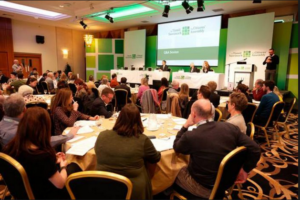
Citizens’ Assembly
As Diarmuid Torney comments, “Through its deliberations over the past seven months, the Committee has provided a forum for serious and sustained political engagement on climate change in a way that was profoundly lacking in the past.” See below in sources.
We will review certain key components of the Committee’s Report, and encourage further reading of it in full.
The Joint Committee Report
The Committee rightly starts with Ireland’s poor performance on climate actions, noting that to be consistent with the Paris Agreement Ireland’s greenhouse gas (GHG) emissions should be reducing by 5-10% each year, yet they continue to grow, e.g., by 4% in 2016. It is soundly concluded that “… the State must move now and quickly to put the structures and systems in place that will ensure that everyone in the State…can work together to make Ireland compliant with our international climate change obligations…” At 7. The Committee then proceeds to explore just what structures and systems are needed to build long-term binding commitments for climate action through 2050.
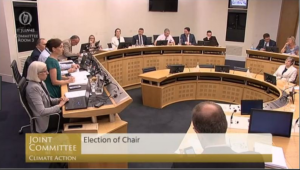
Joint Committee
Legislative and Governing Framework
Initially, the Committee sets down the legislative and governing framework for establishing the climate targets and for implementing the overall strategy for climate action.
The legislative framework for 2019 supporting these commitments will provide for:
1. A target of net zero economy-wide GHG emissions by 2050;
2. A provision for a 2030 target, consistent with the GHG emissions reduction pathway to 2050 to be set by 2020 by Statutory Instrument requiring the formal approval of both Houses of the Oireachtas following receipt of advice from the Climate Action Council;
3. Provision for five–yearly carbon budgets, consistent with the emissions reduction pathway to 2030 and 2050 targets, to be set by Statutory Instrument requiring the formal approval of both Houses of the Oireachtas following receipt of advice from the Climate Action Council;
4. A target for the renewable share of electricity generation of 70% by 2030.
However ambitious this legislative program may seem, the Committee admits that it will not be sufficient to meet the targets.
To deliver these commitments, the Committee constructs a governing structure. The Government will be responsible for allocating the carbon budgets and for meeting the targets. To assist the entire program, the Committee proposes converting the current Climate Change Advisory Council to an independent external expert body to be called the Climate Action Council (Council). Finally, the Oireachtas will create a Standing Committee on Climate Action to monitor the program. The responsibilities of each — the Government, Council and Standing Committee — are explored further.
The Government will establish 5-year carbon budgets based on the recommendations from the Council, which will be accepted or explained why there are not accepted. The Government then will allocate the budget for each Department.
Then the Committee adds that “It will be for the Government to direct public bodies, informed by the best available research, on the most cost effective and politically acceptable strategies that should be pursued in order to meet targets.” (Emphasis added) At 10. While the statement leaves the whole process open for “business as usual,” to be fair to the Committee it is one of the few wholly “political” wiggles included in the Report.
The Climate Action Council will be an extended version of the current Climate Change Advisory Council, with expanded duties and increased resources, including an independent budget and staffing. Its primary obligation is to develop the carbon budgets, provide the best scientific advice to the Government, and report to the Standing Committee. While the Council follows the model of the UK Committee on Climate Change, it has an expansive engaging role that includes facilitating collaboration with state agencies, local business, local authorities, third level colleges and civil society. It also is instructed to work with similar other national bodies on best practices. There are a lot of opportunities here for a proactive Council.
The Standing Committee will be incorporated in new legislation and among other duties it will “1. Examine and call to account all Ministers and public bodies on climate action performance on a regular basis; 2. Review in general all aspects of climate change policy, including mitigation, adaptation, international developments and best practice…” At 11. It asserts that the Oireachtas has a stronger role to play in holding the Government and public bodies to account for climate actions. That is encouraging.
Education and Communication
After setting down the legislative and governing structures, the Committee considers a number of recommendations for climate action. An interesting issue is its treatment of Education and Communication. The issue is actually not one of the recommendations of the Citizens’ Assembly and the Committee makes some proactive recommendations. It urges the relevant bodies responsible for curriculum to review the primary and secondary curricula to make sure climate change is accurately covered so that students are literate on climate change and its impacts. It also recommends that Broadcasting and online platforms develop policies for ensuring that climate change is broadly and fairly covered, even suggesting that the Broadcasting Authority consider setting quotas for climate coverage as it does for current affairs and Irish language programming. It also suggests the Climate Action Council develop its own online broadcasting platform, an imaginative and interesting idea. Finally, in this section, the Committee recommends that Met Éireann take a more proactive approach, where scientifically justified, to link specific weather events to climate change, that it reflect the consensus of the Intergovernmental Panel on Climate Change (IPCC) in its coverage, and that it include a dedicated Climate Communications Section.
Underlying this discussion of Education and Communications, and indeed the entire report, is the considered recognition by the Committee that in all this talk about climate action we are asking people to make significant changes to their lifestyles. That is not an easy ask. And people do not always get the best or most complete information to deal with all the challenges we are presenting to them. It is critical that governments explain clearly and consistently what they are requiring and why. As the Committee notes, the government’s failure to account for these challenges resulted in widespread adverse reactions to wind turbines in some communities.
Incentivising Climate Action
These challenges underpin the section of the report on “Incentivising Climate Action,” where the Committee addresses the task of paying for all the climate actions. At the outset, the Committee acknowledges that doing nothing can be dangerously expensive, in unleashing the full impacts of climate change and in the costs of not complying with EU climate obligations. At the same time, the Committee admits it did not have time to seriously consider in detail what adaptation measures might be called for, and at what expense. These issues will have to be addressed by the Standing Committee, with critical input from the Climate Action Council.
Already in place is the government’s Project Ireland 2040, which includes the National Planning Framework and National Development Plan. Included in the Project is €30 billion for climate action and sustainable transport. Also under consideration is building the price of climate impacts into large investment and infrastructure decisions.
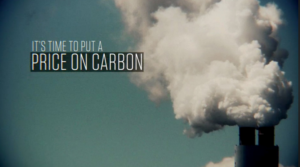
Beyond these measures, the Committee supports some form of carbon pricing that will function as a pricing signal to drive behavior toward a low-carbon economy. It recognizes that carbon pricing is a necessary but not sufficient mechanism, and that the revenue generated should not go to the central fund but be set aside, or ring-fenced, for supporting those suffering from fuel poverty and for returning a dividend to individuals/households. Its recommendation, in part a kicking the can down the road, is that the current price be raised, pursuant further study by the government and advice from the Council, with all due protections for fuel poverty and low-income citizens, and with a ring-fenced revenue stream.
Energy
Key to meeting the target of net zero emissions by 2050, it will be necessary to first develop the transition to 100% renewable electricity. That is no small step by itself. Yet is its only a beginning step as 80% of Ireland’s energy needs are for heating and transport and only 20% of that comes from electricity. Where to get the remaining energy is the real challenge. Converting to electric heat and cars will help.
Luckily Ireland has substantial potential for off-shore wind and ocean energy. On-shore wind got off to a rocky start, in large part because of the lack of communication by the government, as noted above, so that option has its particular challenges. Solar energy has been slow to develop because of poor planning laws and barriers to grid connections.
As for use of fossil fuels in energy production, the Committee states clearly that the use of coal and peat should cease as soon as possible. Moneypoint should also be closed as soon as feasible, with all due protection for the workers as part of the Just Transition to a low-carbon economy. And the government’s support for biomass needs reevaluation.
The technology for producing much of the needed energy is already available but there are considerable regulatory and financial support mechanisms required. What the Committee recommends in this regard constitutes a very long list of actions to be taken by various Ministers. It remains to be seen what the government will buy into and what will fall by the wayside as just more political litter.
The Citizens’ Assembly stressed the need for individual and community participation in solar and wind generation, with connection to the grid and a payment for excess energy. The Committee stands behind the Assembly’s recommendations and supports a feed-in tariff for microgeneration energy with a review of any energy market rules that inhibit such microgeneration.
Agriculture, Forestry and Peatlands
Agriculture dominates this discussion, as it often does when talking about climate action.
But first there is forestry and peatlands, both critical parts of Ireland’s biodiversity. The Committee supports the preservation and enhancement of both resources. In particular, it recommends the restoration of soils to carbon sequestering status in order to limit emissions and to start to reabsorb carbon. The Citizens’ Assembly was strong on protecting peatlands as only 1% of Ireland’s peatlands are subject to rehabilitation or restoration. The Committee recommends the rehabilitation and restoration of various peatlands to achieve net sequestration from peatlands nationally by 2050.
Similarly, appropriate forest management and use of forest products can lead to carbon sequestration and storage. Effective policies to store and sequester carbon can offer substantial co-benefits for tourism, biodiversity, water quality and management, and for climate resilience.
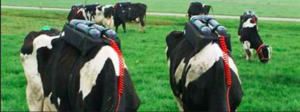
As for agriculture, there is little new incentivising the sector to do more than it is not doing now. As is usual, any government or political discussion of agriculture begins with a tribute to “Ireland’s largest indigenous industry, producing high quality food and drinks that are recognised worldwide.” At 63. As usual, this is followed by how important farming is to rural life in Ireland. Note that when the point is to play to the sentiments of rural life, the switch is from agriculture (typically large scale operations) to farming (mom and pop family farm). For instance, “Farmers and landowners, as custodians of the land, and as those who may be impacted most severely by climate change, have an intimate knowledge of and actively manage the land and will drive solutions forward.” At 63. Then there is the obligatory fact that GHG emissions from agriculture, especially methane, are about 32% of Ireland’s total GHG emissions, in comparison to about 7-9% across the EU. Finally, there is a plea for agriculture, or farmers, to do their duty to help climate action by being more efficient and out-producing other countries. Most often the farming community is urged to adopt various programs from Teagasc that are supposed to make them low-carbon (with little focus on the real culprit, methane).
To the Citizens’ Assembly’s credit, it cut through much of this narrative to recommend: a tax on GHG emissions from agriculture (not just carbon), with the revenue dedicated to supporting climate friendly agriculture practices; and support for the farming community’s just transition to lower GHGs, as with the peat cutters in the Midlands.
The Committee kicks this can down the road as well, relying on some reform of the EU Common Agriculture Policy (CAP) and its financial support system to deal with Irish agriculture. As for the Assembly’s proposal for a GHG tax, the Committee walks away from that grenade finding that “The issues around taxation as a means to manage agricultural emissions are complex and were not considered by the Committee in sufficient detail.” At 66. Perhaps this evasion is not unexpected since the government quashed any notion of an agriculture GHG tax as soon as it surfaced during the Assembly’s deliberations.
The Committee also relies on work done by Teagasc in developing 28 GHG abatement measures for the sector and hopes the sector will adopt these measures. The problem is that Teagasc has contributed many suggested improvements over the years but they are largely voluntary, and largely ignored by the sector. It must be said, though, that Teagasc lately has been more proactive in pushing for these measures. Whether the sector responds remain to be seen.
With regard to its recommendations on agriculture, forestry and peatlands, the Committee recommends that all these sectors be re-examined in light of the IPCC Special Report on Climate Change and Land (SRCCL), which is scheduled for publication in August 2019.
Built Environment
GHG emissions from the residential and public buildings stock represents about 11% of Ireland’s GHGs. There is little new in what needs to be done: convert heating sources to renewables, including heat pumps run off the grid supplied with renewable energy, and retrofit older homes with insulation, and subject new homes to tighter insulation requirements.
While the ideas are simple enough, the task is not, primarily because of the costs. The Committee notes that there were about 1.7 million permanent housing units occupied at the time of the 2016 Census and according to the SEAI only about 15.6% have the most energy efficient rating. That would suggest that the requirement for retrofitting is of the order of at least 1.5 million houses, including 130,000 social housing units that are the direct responsibility of housing authorities.
The Committee recommends that priority for retrofitting begin with houses relying on coal or peat for heating, then those with oil, and then those with gas.
As the public housing authorities are responsible for a significant number of units, clearly public leadership on sorting out the financing of retrofitting is appropriate. Public procurement is a widely underutilised tool in Ireland.
The Committee also notes the particular problem with retrofitting rental properties where the landlord is responsible for paying for the retrofit and tenants reap the benefit of lower energy bills. An analysis of this area by the relevant Minister is recommended.
Transport
The record of the government on transport remains inadequate. The targets in its Smarter Travel: A Sustainable Transport Future, for 2009-2020, have not been met, and the first National Cycle Policy Framework, launched in 2009, has had limited implementation.
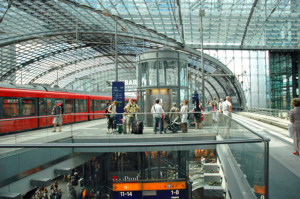
In light of such ongoing failures, the Committee endorses all three of the Citizens’ Assembly recommendations for: greatly increasing the number of bus and cycle lanes and park-and-ride facilities, with priority over private car use; support for transition to electric vehicles; and the expansion of public transport spending over new road infrastructure spending at a ratio of no less than 2-to-1, including for rural areas.
With regard to the latter relative spending ratio, the Committee cautiously notes that “such a ratio is not tailored to adequately guide all transport investment, given that investment in a road can incorporate bus lanes, cycle lanes and footpaths.” At 90. Nevertheless, the Committee agrees with the Assembly “that there is an urgent need to rebalance investment towards mass transport solutions…” At 90. And any future transport projects will be evaluated under the revised Spending Code where all investment decisions will fully reflect the social cost of carbon emissions.
Conclusion
As the Committee noted earlier, the Oireachtas has a stronger role to play in holding the Government and public bodies to account for climate actions. Certainly the government and its Departments need all the oversight that can be brought to bear. And now we have the Oireachtas’ Standing Committee on the record for what it believes is necessary to finally take a serious view of climate action. As it holds others accountable, we can hold it accountable.
A critical watchful eye by the public is key to making sure the Citizens’ Assembly and Joint Committee recommendations are acted on. For all the positive statements and sentiment in both the Assembly and Committee reports, they are still just words until the government and Oireachtas act.
Sources:
Tuarascáil ón gComhchoiste um Ghníomhú ar son na hAeráide An tAthrú Aeráide: Comhdhearcadh Traspháirtí don Ghníomhú. Report of the Joint Committee on Climate Action, Climate Change: A Cross-Party Consensus for Action (March 2019). bit.ly/2OvmlED
Diarmuid Torney, “What’s in Ireland’s landmark climate change report?” RTE/Brainstorm (29 March 2019). bit.ly/2W3xeQ7
“A Tipping Point on Climate Change in Ireland?” in Reports section of irish environment (January 2018). bit.ly/2MHVNSd
“Ireland is Still Lagging on Climate Change” in Reports section of irish environment (April 2019). bit.ly/2wqAA5a


No comments yet, add your own below